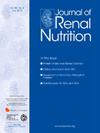MyPlate Awareness and Engagement and Perceived and Objective Diet Quality in US Adults With Chronic Kidney Disease
IF 3.4
3区 医学
Q2 NUTRITION & DIETETICS
引用次数: 0
Abstract
Objective
Awareness of federal dietary guidelines has been associated with better perceived and objective diet quality. Little is known about the awareness of federal dietary recommendations among persons with chronic kidney disease (CKD) and the associations between recognition of guidelines, perception of diet quality, and objective quality of the diet in this population.
Design and Methods
We compared awareness of, and engagement with, MyPlate (a representation of 5 food groups from the US Department of Agriculture) along with perceived and objective diet quality, the latter assessed via Dietary Approaches to Stop Hypertension index scores, among US adults with and without CKD during 2017-2020.
Results
Among noninstitutionalized adults in the United States, 8.3% had albuminuria with normal or near-normal kidney function, 4.0% had estimated glomerular filtration rate 45-59 mL/minute/1.73 m2 (CKD stage G3a) and 1.6% had estimated glomerular filtration rate <45 mL/minute/1.73 m2 (CKD stages G3b/G4/G5). MyPlate awareness was lower among persons with CKD compared with those without CKD (19.6% vs. 26.4%, P < .001) and was lower among persons with more advanced CKD stages: 20.8%, 18.2%, and 16.3% in persons with CKD stages G1/G2, G3a, and G3b/G4/G5, respectively (trend P < .001). Among persons aware of MyPlate, a numerically higher proportion with CKD attempted to follow MyPlate recommendations (43.9% vs. 32.3%, P = .10); the proportion was highest among persons with moderate-to-advanced CKD (41.9%, 42.9%, and 56.9% among persons with CKD stages G1/G2, G3a, and G3b/G4/G5, respectively (trend P < .001)). Perceived and objective dietary quality (the latter based on concordance with the Dietary Approaches to Stop Hypertension diet) were slightly higher among persons with CKD relative to those without CKD.
Conclusions
Adults with CKD have lower MyPlate awareness than adults without CKD. Enhancing diet education to persons with CKD could improve diet quality and potentially ameliorate CKD-associated complications.
美国成人慢性肾病患者对 "我的餐盘 "的认识和参与程度以及感知和客观饮食质量。
目的:对联邦膳食指南的认识与更好的感知和客观饮食质量有关。对于慢性肾脏病(CKD)患者对联邦膳食建议的认识,以及该人群对指南的认识、对饮食质量的感知和客观饮食质量之间的关联,我们知之甚少:设计:我们比较了 2017-2020 年期间患有和未患有 CKD 的美国成年人对 MyPlate(美国农业部的五种食物类别代表)的认知度和参与度,以及对饮食质量的感知和客观饮食质量,后者通过膳食方法阻止高血压(DASH)指数评分进行评估:在美国非住院成年人中,8.3%的人有白蛋白尿,肾功能正常或接近正常,4.0%的人估计肾小球滤过率(eGFR)为45-59 mL/min/1.73m2(CKD分期G3a),1.6%的人eGFR为2(CKD分期G3b/G4/G5)。与非慢性肾脏病患者相比,慢性肾脏病患者对 MyPlate 的认知度较低(19.6% 对 26.4%,p 结论:患有慢性肾脏病的成年人对 MyPlate 的认知度低于未患慢性肾脏病的成年人。加强对慢性肾脏病患者的饮食教育可以提高饮食质量,并有可能改善与慢性肾脏病相关的并发症。
本文章由计算机程序翻译,如有差异,请以英文原文为准。
求助全文
约1分钟内获得全文
求助全文
来源期刊

Journal of Renal Nutrition
医学-泌尿学与肾脏学
CiteScore
5.70
自引率
12.50%
发文量
146
审稿时长
6.7 weeks
期刊介绍:
The Journal of Renal Nutrition is devoted exclusively to renal nutrition science and renal dietetics. Its content is appropriate for nutritionists, physicians and researchers working in nephrology. Each issue contains a state-of-the-art review, original research, articles on the clinical management and education of patients, a current literature review, and nutritional analysis of food products that have clinical relevance.
 求助内容:
求助内容: 应助结果提醒方式:
应助结果提醒方式:


